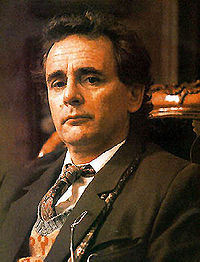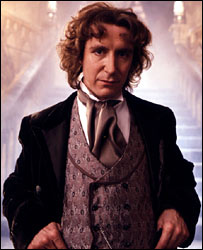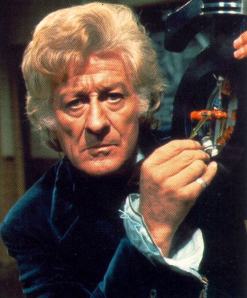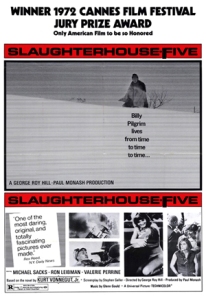So, I’ve finally had a chance to see at least one serial of all eleven doctors in Doctor Who. I understand that this post will be completely subjective, but honestly, this is my blog, so isn’t it all completely subjective any way? Well, here goes, my list of favorite actors who have portrayed the time-traveling Time Lord simply known as “The Doctor” from 1963 all the way up to last Saturday night:
11. Colin Baker – 1984-86 – Doctor #6

I’m so sorry, Colin. He always gets a bad rap and, to be fair, there was a lot of pressure against the show during this time and some of the worst scripts as well. Even still, however, something about (this) Baker’s portrayal of the Doctor just rubs you wrong. Compared to many of the other Doctors, he was brash, (more) arrogant and sometimes just downright mean to his companions. Not to mention, what the hell was he wearing!?! Most of the Doctor’s outfits over the years, though eccentric, have still been pretty cool. This rainbow infested disaster, however, wouldn’t even make the “cool” ranking of a four year old. Again, Colin, I’m sorry, you seem like a great guy in real life, but as the Doctor, I just couldn’t dig your interpretation.
10. William Hartnell – 1963-66 – Doctor #1
 I know, some of you are going to berate me for putting the original Doctor this low on the list. It’s true, he provided the groundwork that all the other Doctors elaborated upon, not to mention he made the show famous from the beginning episodes. This crotchety grandfather-like figure as the Doctor just doesn’t have enough fun though! I like Doctors that know how to be serious, but also have that ridiculously zany element we’ve all come to know and love. Hartnell’s first Doctor also seemed too absent-minded and feeble for me to completely enjoy. In fact, unfortunately due to his poor health near his final episodes as the character, Hartnell would flub lines, so some of the idiosyncrasies of the character can’t wholly be deduced to acting. It’s a shame he was so ill near the end and God bless the man for continuing to do what he loved for as long as he could. A salute to you, sir, for your original portrayal and I dug the Victorian costume, but my favorite Doctors lie ahead.
I know, some of you are going to berate me for putting the original Doctor this low on the list. It’s true, he provided the groundwork that all the other Doctors elaborated upon, not to mention he made the show famous from the beginning episodes. This crotchety grandfather-like figure as the Doctor just doesn’t have enough fun though! I like Doctors that know how to be serious, but also have that ridiculously zany element we’ve all come to know and love. Hartnell’s first Doctor also seemed too absent-minded and feeble for me to completely enjoy. In fact, unfortunately due to his poor health near his final episodes as the character, Hartnell would flub lines, so some of the idiosyncrasies of the character can’t wholly be deduced to acting. It’s a shame he was so ill near the end and God bless the man for continuing to do what he loved for as long as he could. A salute to you, sir, for your original portrayal and I dug the Victorian costume, but my favorite Doctors lie ahead.
9. Tom Baker – 1974-81 – Doctor #4
 O.K., so I’m sure most of you expected to see the second Baker a bit higher on the list. I’ve given him a fair shake by watching several serials, but just can’t put him any higher than this lowly position of number 9. During his run, which was the longest of any Doctor to date, he epitomized the character with his off-the-wall elusive behavior, wild hair and elongated scarf. In my opinion, however, I just couldn’t buy into it. His delivery at times seems stilted and his inability to take charge of the situation was just too distracting for me to fully ingest his portrayal of the Doctor. So, for you upset over this choice, would you like a Jelly Baby?
O.K., so I’m sure most of you expected to see the second Baker a bit higher on the list. I’ve given him a fair shake by watching several serials, but just can’t put him any higher than this lowly position of number 9. During his run, which was the longest of any Doctor to date, he epitomized the character with his off-the-wall elusive behavior, wild hair and elongated scarf. In my opinion, however, I just couldn’t buy into it. His delivery at times seems stilted and his inability to take charge of the situation was just too distracting for me to fully ingest his portrayal of the Doctor. So, for you upset over this choice, would you like a Jelly Baby?
8. Peter Davison – 1981-84 – Doctor #5
 From this point in our list on are Doctors that I really liked. Not until our 5th entry do we get to the Doctors that I loved, but the next few entries at least get my one thumb up approval. Davison, when cast, was the youngest Doctor to date. In fact, he is still the second youngest even 30 years later. With an outfit that looked like a mix of tennis court yuppie and panama jack, not to mention the curious piece of celery, this Doctor ushered us into the 1980s. He was young, spirited and actually took great care in listening to his companions. I really enjoyed Davison as the Doctor and think he did a wonderful job, even despite the fact that some of his episodes weren’t the best written. His final episode, The Caves of Androzani (a bit overrated in my opinion, but still great), continues to top lists of the best episodes ever for the series.
From this point in our list on are Doctors that I really liked. Not until our 5th entry do we get to the Doctors that I loved, but the next few entries at least get my one thumb up approval. Davison, when cast, was the youngest Doctor to date. In fact, he is still the second youngest even 30 years later. With an outfit that looked like a mix of tennis court yuppie and panama jack, not to mention the curious piece of celery, this Doctor ushered us into the 1980s. He was young, spirited and actually took great care in listening to his companions. I really enjoyed Davison as the Doctor and think he did a wonderful job, even despite the fact that some of his episodes weren’t the best written. His final episode, The Caves of Androzani (a bit overrated in my opinion, but still great), continues to top lists of the best episodes ever for the series.
7. Christopher Eccleston – 2005 – Doctor #9
 I began the series with the 2005 reboot, so this was essentially my first Doctor (though not MY Doctor as many people state). I have to give him some credit for engaging me in the program and helping bring me into the world of Whovians. Though, in reality, he has been my least favorite of the rebooted Doctors. He switched back and forth between quirky and crazy to intensely serious on the drop of a hat. This element alone is enough to make you ask exactly what type of emotions is going through this war-born Time Lord. I wish he would have picked a side, one way or the other, but other than that – nice run Eccleston!
I began the series with the 2005 reboot, so this was essentially my first Doctor (though not MY Doctor as many people state). I have to give him some credit for engaging me in the program and helping bring me into the world of Whovians. Though, in reality, he has been my least favorite of the rebooted Doctors. He switched back and forth between quirky and crazy to intensely serious on the drop of a hat. This element alone is enough to make you ask exactly what type of emotions is going through this war-born Time Lord. I wish he would have picked a side, one way or the other, but other than that – nice run Eccleston!
6. – Sylvester McCoy – 1987-89, 1996 – Doctor #7
 I know a lot of people hate McCoy. I know, it was with his Doctor that the series sank to all-time lows and initiated a nearly 16 year hiatus (of course, outside of the Doctor Who Movie in 1996). To further clarify my placement of McCoy, I have only seen serials from his latter tenure which included companion Ace. From what I have seen from these later episodes, which have consistently been rated much higher than his earlier episodes, I have really enjoyed him. He has a dark demeanor and is very much a Sherlock Holmes-like Doctor. Not to mention, his interactions with Ace are some of the best Doctor/Companion interactions I think I’ve seen on the show outside of Rose and the 10th Doctor. And, trust me, that’s saying a lot!
I know a lot of people hate McCoy. I know, it was with his Doctor that the series sank to all-time lows and initiated a nearly 16 year hiatus (of course, outside of the Doctor Who Movie in 1996). To further clarify my placement of McCoy, I have only seen serials from his latter tenure which included companion Ace. From what I have seen from these later episodes, which have consistently been rated much higher than his earlier episodes, I have really enjoyed him. He has a dark demeanor and is very much a Sherlock Holmes-like Doctor. Not to mention, his interactions with Ace are some of the best Doctor/Companion interactions I think I’ve seen on the show outside of Rose and the 10th Doctor. And, trust me, that’s saying a lot!
5. Paul McGann – 1996 – Doctor #8
 Outside of audio stories, McGann only had one chance on television to grace us with his portrayal of the Doctor. Though the movie wasn’t amazing, I liked it. What I loved, however, was Paul McGann’s awesome performance. He was witty, eccentric, yet very much in control and concerned with saving the world. His outfit was completely bad-ass as well! A Victorian Buffalo Bill mixture that is elegant, yet weird. I wish we could have seen Paul McGann grow the character onscreen a bit more. I immediately enjoyed his portrayal, and everyone knows it usually takes several episodes before you start to warm up to a new Doctor. If he’d had the chance, I think he could have been one of the best yet.
Outside of audio stories, McGann only had one chance on television to grace us with his portrayal of the Doctor. Though the movie wasn’t amazing, I liked it. What I loved, however, was Paul McGann’s awesome performance. He was witty, eccentric, yet very much in control and concerned with saving the world. His outfit was completely bad-ass as well! A Victorian Buffalo Bill mixture that is elegant, yet weird. I wish we could have seen Paul McGann grow the character onscreen a bit more. I immediately enjoyed his portrayal, and everyone knows it usually takes several episodes before you start to warm up to a new Doctor. If he’d had the chance, I think he could have been one of the best yet.
4. Matt Smith – 2010-present – Doctor #11
 Our current Doctor, Matt Smith. At first, I was not sure what to think of him, but he has proven himself quite well. He is definitely eccentric and on the weird side of Doctor characterizations, but he also knows how to take control and fight back when the situation calls for it. Furthermore, with Stephen Moffatt behind him as the creative force, his stories are becoming some of the best yet. Smith has also single-handedly made bow ties quite cool once again! Who knows, in time, I may move Smith up even higher on my list, but for now, he will stand at the still admirable number 4 position. Geronimo!
Our current Doctor, Matt Smith. At first, I was not sure what to think of him, but he has proven himself quite well. He is definitely eccentric and on the weird side of Doctor characterizations, but he also knows how to take control and fight back when the situation calls for it. Furthermore, with Stephen Moffatt behind him as the creative force, his stories are becoming some of the best yet. Smith has also single-handedly made bow ties quite cool once again! Who knows, in time, I may move Smith up even higher on my list, but for now, he will stand at the still admirable number 4 position. Geronimo!
3. Jon Pertwee – 1970-74 – Doctor #3
 Dare I say, our most adventurous Doctor? With cape and dashing personality to match, Pertwee was the James Bond of Doctors. He was cool, conservative and sometimes overly confident. Forced for most of his tenure to assist U.N.I.T. on Earth, Pertwee had a great relationship with his companion, fellow researcher Jo. Out of all the serious incarnations of the Doctor, who had little time for zaniness, Pertwee is my favorite. Don’t get me wrong though, his witty and cynical remarks born from his ego are some of the funniest lines from this era of the series. I can’t wait to continue working my way through Pertwee’s tenure as the Doctor, and remember, to always reverse the polarity of the neutron flow.
Dare I say, our most adventurous Doctor? With cape and dashing personality to match, Pertwee was the James Bond of Doctors. He was cool, conservative and sometimes overly confident. Forced for most of his tenure to assist U.N.I.T. on Earth, Pertwee had a great relationship with his companion, fellow researcher Jo. Out of all the serious incarnations of the Doctor, who had little time for zaniness, Pertwee is my favorite. Don’t get me wrong though, his witty and cynical remarks born from his ego are some of the funniest lines from this era of the series. I can’t wait to continue working my way through Pertwee’s tenure as the Doctor, and remember, to always reverse the polarity of the neutron flow.
2. Patrick Troughton – 1966-69 – Doctor #2
 Unfortunately, many of Troughton’s episodes no longer exist due to the BBC’s clearing policy in the late 1960s and early 1970s. However, what is left is testament to his amazing portrayal of the character. He was the first Doctor to not be so serious all the time, a “Cosmic Hobo” if you will. Despite his goofy antics and somewhat aloof personality, this Doctor could be extremely effective and usually knew what was going on well before his stumped companions. One of the subtlest actors in the role, this flute playing, Chaplinesque Doctor is one of my absolute favorite. Now, if I can just scour the Earth for the rest of his lost episodes…
Unfortunately, many of Troughton’s episodes no longer exist due to the BBC’s clearing policy in the late 1960s and early 1970s. However, what is left is testament to his amazing portrayal of the character. He was the first Doctor to not be so serious all the time, a “Cosmic Hobo” if you will. Despite his goofy antics and somewhat aloof personality, this Doctor could be extremely effective and usually knew what was going on well before his stumped companions. One of the subtlest actors in the role, this flute playing, Chaplinesque Doctor is one of my absolute favorite. Now, if I can just scour the Earth for the rest of his lost episodes…
1. David Tennant – 2005-2010 – Doctor #10
 This is it, the end of our list. Here we come to MY doctor, David Tennant. When he first arrived on the scene, I had no idea what to think of him. As time progressed, however, Tennant’s portrayal of the Doctor as a goofy, caffeine-induced super hero, complete with maroon chucks and brown duster, became my favorite. I don’t know whether I’ll ever like an actor in the role as much as I enjoyed Tennant. He will definitely be a hard act to follow and whenever I think of the Doctor, this is who comes to my mind first. Well, there you have it, my countdown of the actors who have portrayed the Doctor. Until next time, Allons Y!!!
This is it, the end of our list. Here we come to MY doctor, David Tennant. When he first arrived on the scene, I had no idea what to think of him. As time progressed, however, Tennant’s portrayal of the Doctor as a goofy, caffeine-induced super hero, complete with maroon chucks and brown duster, became my favorite. I don’t know whether I’ll ever like an actor in the role as much as I enjoyed Tennant. He will definitely be a hard act to follow and whenever I think of the Doctor, this is who comes to my mind first. Well, there you have it, my countdown of the actors who have portrayed the Doctor. Until next time, Allons Y!!!
**ALL IMAGES COPYRIGHT BBC WORLDWIDE**














![twilight-zone[1]](https://notesonafilm.files.wordpress.com/2011/05/twilight-zone1.jpeg?w=219&h=300)



